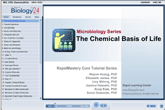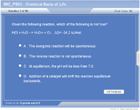| How to Learn in 24 Hours? |
|
| Need Help? |
M-F: 9am-5pm(PST):
Toll-Free: (877) RAPID-10
or 1-877-727-4310
24/7 Online Technical Support:
The Rapid Support Center
vip@rapidlearningcenter.com
Secure Online Order:

|
| Tell-A-Friend: |
Have friends taking science and math courses too? Tell them about our rapid learning system.
|
|
Chemistry of Life
| Topic Review on "Title": |
Structure of Atoms:
- Consist of protons, neutrons and electrons.
- Atomic nuclei have protons and neutrons (each 1 amu).
- Each element has a different number of protons, e.g. hydrogen has 1 proton, carbon 14.
- The number of protons equals the atomic number of an element.
- Atoms with the same number of protons but different numbers of neutrons are isotopes.
- Cells of living organisms consist of organic and inorganic molecules which are made up of atoms.
Electrons
- The number of electrons (e-) equals the number of protons in the nucleus.
- Electrons move at near light speed, have both wave and matter properties, when their energy level is raised they are said to be in an “excited state”, emission spectra is when this excited electron drops back to its ground state.
- Electrons orbit the nucleus at specific levels called shells. The shell closes to the nucleus is the innermost shell and has up to 2 electrons. Second and third shells (L and M) have a maximum of 8 electrons. If an element has another shell that is filled it is chemically inert.
Chemical Bonds
- Bonds are formed by gaining, loosing or sharing electrons.
- The formation of ionic or covalent bonds depends on the differences between electronegativity in the atoms involved.
- Covalent bonds: formed when atoms share electrons and are very strong. They are polar if they are between different types of atoms e.g. oxygen and hydrogen as in H2O.
- Ionic Bonds: atoms become ions when they gain or lose electrons and are weaker than covalent and dissociate in water.
- Hydrogen Bond: are weak intra or inter molecular attractions between molecules with a net dipole. Dipoles are created when there is unequal sharing of electrons between H and an electronegative atom like oxygen or nitrogen.
Organic Molecules
- Molecular formulas describe the composition of a substance.
- Structural formulas describe how atoms are arranged in a molecule.
- Nomenclature is the naming procedure for organic molecules.
- Stereochemistry are isomers that have the same molecular formula but different structural formulas.
Nomenclature
- Single bond share one pair of electrons and name ends in (–ane).
- Double bonds share two pairs of electrons, name ends in (-ene).
- Triple bonds share three pairs of electrons, name ends in (-yne).
Biological Macromolecules
- Carbohydrates: made up of monosaccharides (e.g. glucose), stores energy, and modifies other macromolecules (glycolipids, glycoproteins).
- Lipids fat triglycerides (glycerol), phospholipids, stores energy, makes up cell membranes and steroid hormones.
- Proteins: single amino acids join forming peptides, functions as structural proteins and enzymes.
- Nucleic Acids: individual nucleotides link to form genetic material, RNA, DNA.
Acids, Bases and Buffers
- Electrolytes are substances that release ions in water.
- Acids release H+ in water.
- Bases release OH- in water.
- Strong acids and bases completely dissociate in H2O.
- pH is the concentration of hydrogen ions [H+] in solution. At pH 7 hydrogen ion concentration equals hydroxyl concentration, [H+] = [OH-].
- Buffers provide pH stability by resisting changes to pH when small amounts of acid or base are added.
- Buffers are weak acids or weak bases and their salts.
Biochemical Reactions
Thermodynamics:
- First Law: Energy is always concerned and cannot be created or destroyed.
- Second Law: Systems tend to become disordered.
- Entropy (S): describes the degree of disorder in a system.
- ΔG Gibbs Free Energy is the amount of energy available to do work.
- ΔG= ΔH - T ΔS (ΔH is enthalpy change), ΔS entropy change, T=temperature (K)
- If ΔG<0 spontaneous reaction, If ΔG>0 non-spontaneous reaction, If ΔG=0 reaction is at equilibrium.
- Enzymes in biochemical reactions lower the activation energy. Activation energy is the energy required to begin a reaction.
- Types of enzyme reactions: oxidoreductase, transferase, hydrolase, ligase, isomerase and ligase.
|
| Rapid Study Kit for "Title": |
| Flash Movie |
Flash Game |
Flash Card |
| Core Concept Tutorial |
Problem Solving Drill |
Review Cheat Sheet |
 |
 |
 |
|
| "Title" Tutorial Summary : |
This module reviews basic inorganic and organic chemistry as well as basic thermodynamics. The make up of atoms and the basis for their reactions are described. The thermodynamics of reactions are introduced and the importance of enzymes on lowering the activation energy of chemical reactions in a cell are presented. Reactions that would normally not proceed or proceed very slowly are possible in a cell due to the effects of enzymes.
The most important chemical units in biological systems are presented. These units combine in an ordered fashion to make the macromolecules required by the cell. The cell’s chemistry facilitates the formation of the macromolecules and pH swings which might occur as a by product of these reactions are prevented by buffers.
|
| Tutorial Features: |
Specific Tutorial Features:
- Chemical bonds: ionic, hydrogen and covalent bonds in organic and inorganic chemistry are described.
- Reactions involving a change in bonds are elucidated.
- Thermodynamics of organic, inorganic and enzymes are detailed.
- The composition of atoms is neutrons, protons and electrons.
- Atoms form chemical bonds in which electrons are lost, gained or shared.
- Buffers act to stabilize the pH and keep it from changing when small amounts of acids or base is added.
- Organic chemicals are made up of functional groups which when combined can create macromolecules.
- Enzymes are vital to a cells survival and act to lower the energy required to carry out biologically critical reactions.
Series Features:
- Concept map showing inter-connections of concepts.
- Definition slides introduce terms as they are needed.
- Examples given throughout to illustrate how the concepts apply.
- A concise summary is given at the conclusion of the tutorial.
|
| "Title" Topic List: |
Organic Molecules:
Atoms: electrons involved in reactions to form or break bonds in molecules and organic molecules.
Atoms are made up of protons, neutrons and electrons.
Atoms make up elements and elements make up molecules. Molecules in specific arrangements for cells of living organisms.
|
See all 24 lessons in Anatomy and Physiology, including concept tutorials, problem drills and cheat sheets:
Teach Yourself Microbiology Visually in 24 Hours
|



